Stay safe working in ceilings
 Working in ceilings is common for electricians, it is also extremely dangerous.
Working in ceilings is common for electricians, it is also extremely dangerous.
There are serious electrical safety and other risks in ceiling spaces. It’s important to understand and manage these before entering a ceiling space.
In most buildings, the ceiling space is where electrical wiring for lights, sockets, air-conditioning and other electrical equipment runs. Any time a person is working in ceiling space they are at risk of being shocked.
As ceilings can be where the electrical supply line enters a property, turning off the power at the meter box may not eliminate the risk of shock or electrocution.
Read more from MEA
- Solar installer fined for unsafe work
- Changes to award terms on casual conversion
- Enphase: New solar standard opportunities
The presence of solar panels is another factor that must be considered. As they generate power separate from the mains and are connected to the roof, they can pose a risk of electrocution or shocks.
Similarly, when working in ceiling spaces a person there is also a risk of falling through ceilings. Heat stress can also be a health concern, as in summer temperatures in ceiling spaces can exceed 50 degrees due to the heat from the roof.
Dust, moulds, and vermin are also common in ceilings and must be considered. For homes built before 1990 asbestos dust could also be present.
While isolating power in the ceiling is not a legal requirement in states other than Western Australia, most State’s safe work authorities recommended that as best practice.
Tips for working in ceiling space
To avoid electrocution:
- Switch off supply to area before you touch, move or physically disturb any electrical wiring, cable or junction box connection.
- Only attempt electrical work or tasks where you have the required skills or qualifications.
To avoid heat-related illness you must:
- determine the safe entry time by assessing the temperature, through feeling for and/or measuring heat, before entering the space
- ensure all workers are trained in heat-risk awareness and how to recognise heat stress symptoms in themselves and their workmates.
Other safety considerations include:
- eliminating or minimising the danger from vermin or insect activity before entry into the roof / ceiling space
- using crawl boards to walk across ceiling space
- ensuring your entry and exit points are easily accessible
- stabilising and securing ladders to avoid slipping when being used
- using appropriate personal protective equipment.
Master Electricians have unlimited, direct access to the MEA Safety Hotline. If you need assistance with safety on your worksite call 1300 889 198 to speak to the experts.